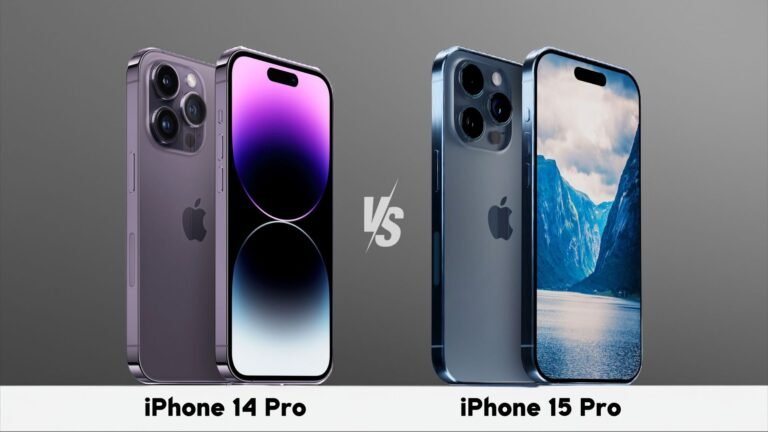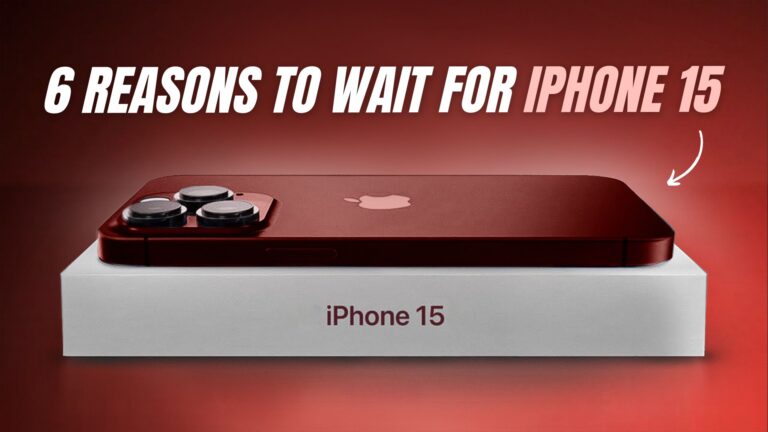In this article, we’ll be comparing what many believe to be the best iOS and Android devices, covering all of the differences between each phone, and deciding which one offers the best value for money.
Design
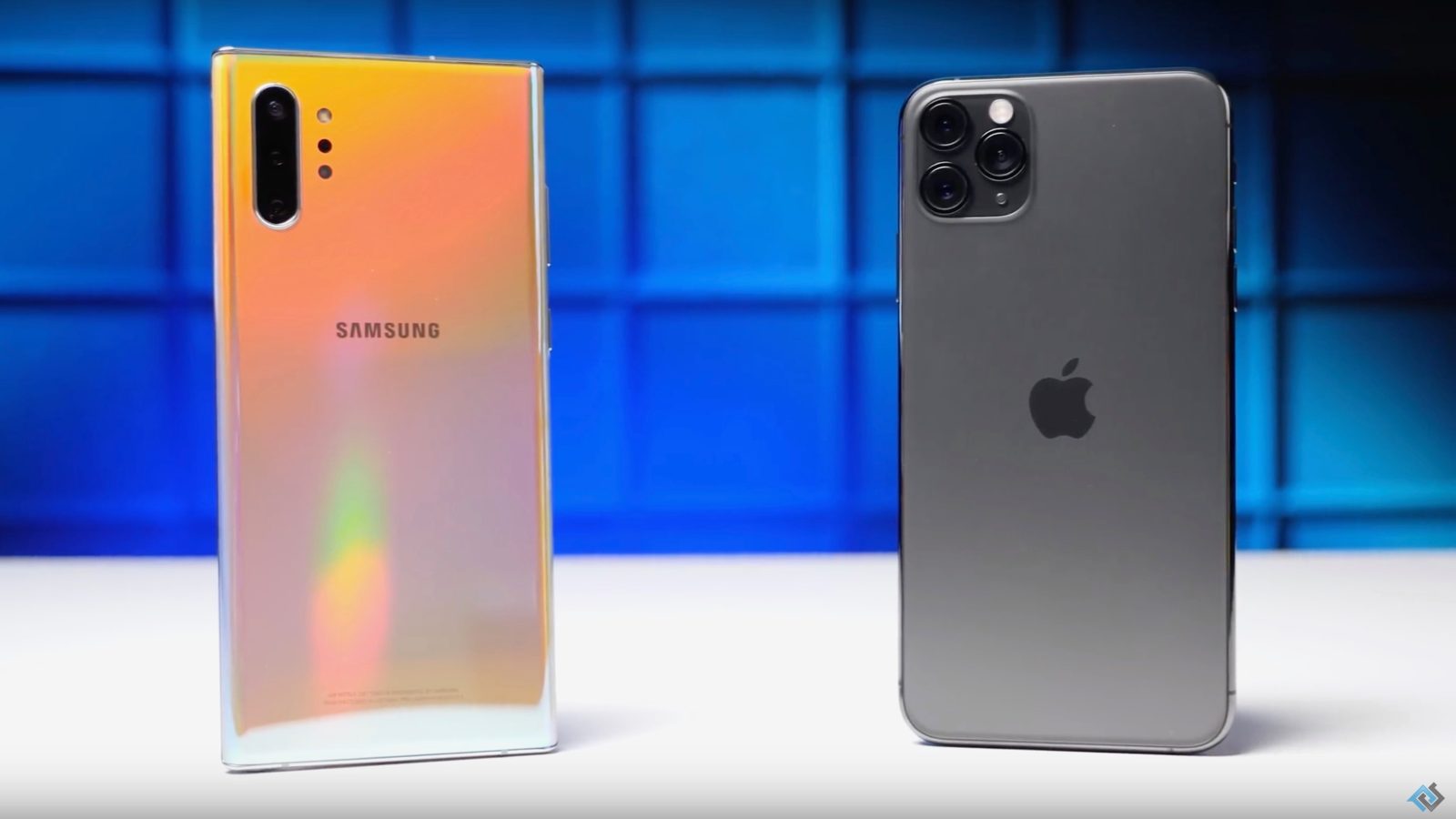
Both phones have a glass sandwich designed with metal frames. Gorilla Glass 6 used in the note 10 plus. Apple don’t specify the glass used in their phone but do claim once again to have the strongest glass in any smartphone.
Drop test comparing these two phones are pretty inconclusive and have shown both phones to be the victor in different situations. There isn’t a definitive answer as to which is more durable. The only guaranteed takeaway is that both phones are made of glass which can shatter if you drop them.
One thing I should mention though is that the note has curved glass on both sides which wraps around a lot further on the edges than the iPhone. So if you did happen to drop these without a case there’s more chance of the notes landing on this glass panels and breaking.
The iPhone does have one surefire durability advantage though because this metal frame is made from stainless steel one of only a few smartphones to do so. Stainless steel is much harder than the aluminum found in the note 10 plus. So the iPhone will be more scratch-resistant.
The iPhone is also the more water-resistant of the two phones with protection against submersion up to four meters versus one and a half meters in the notes 10 plus.
The iPhone has the power button and SIM card tray on the right-hand side. But new for notes this year is the removal of the power button which is now integrated into the Bigsby button on the left side.
Having drastically reduced the speaker grill Samsung has now placed a speaker on top of the phone alongside the microphone and SIM card tray. This is a huge advantage over the iPhone single SIM card slot which can only have a dual SIM setup with the ESM and doesn’t offer any expandable storage at all.
The iPhone does have a full-size top speaker I did find it easier to hear people during phone calls who in turn found me easier to hear then on note ten plus.
The bottom of the phones we have the microphones and speaker grilles the s-pen in the note 10 plus and the USBC and lightning ports for charging.
These are the largest phones that each company offers with the exception of the galaxy fold and have very similar dimensions. The note is the taller device but is also thinner, narrower, and noticeably lighter than the 11 pro-Max.
There are two major design differences with the rear panels. First of all the iPhone now has a frosted glass texture which I have to say feels really good in the hand and along with the rounded corners this makes holding the iPhone much more comfortable than the note 10 plus. As beautiful as the notes glossy finishes, it’s a huge fingerprint magnet which now isn’t a problem on the iPhone. The second is, of course, the camera design. The iPhone was initially met with some criticism of its new triple-lens camera module but it does look much better in real life on the finished models. The note more traditional camera alignment is arguably more sleek and elegant.
Displays
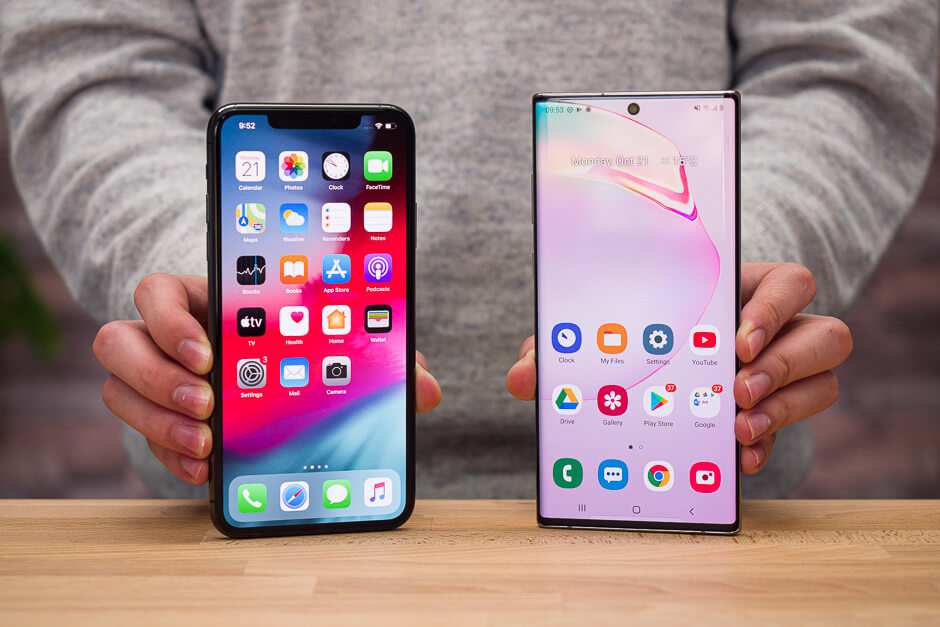
There are actually quite a few similarities here. With the same color range brightness and contrast ratio in each phone. Samsung’s larger 6.8-inch display does have the advantage in screen resolution though it’s 1440p display has a much higher pixel density. It also supports HDR 10 plus which the iPhone strangely doesn’t. Despite also having a peak brightness of 1200 nits. Realistically though there isn’t much content supporting HDR 10 plus yet anyway.
Both phones supports the more popular HDR 10 and Dolby vision though so along with Dolby Atmos support watching movies is fantastic on both phones.
The iPhone does have better speakers though and with the new spatial audio feature, your content is more immersive. The full-size front speaker grille provides better stereo separation to and cranking the volume up to max the sound is louder on the iPhone. You want to be able to hear the spatial audio effect over YouTube but you should be able to hear the difference in volume.
When it comes to YouTube content the note does have a big advantage. Not only can you watch it 1440p resolution but you can also watch HDR content which currently isn’t possible on the iPhone.
The iPhone beats the nose display with two features though. The first is true tone which automatically adjusts the white balance based on the lighting conditions. The note 10 plus does have a blue light filter but it’s not as effective or sophisticated as true toned. The second is that the iPhone screen is completely flat which eliminates accidental screen presses when holding the phone. It also means that none of your content is distorted at the edges which some people prefer.
The note 10 plus is able to achieve razor thin bezels much thinner than on the iPhone. So there are advantages to both. The note bezels are actually thinner on the top and bottom too. But perhaps a bit more noticeable in contrast to the thinner side bezels so some people may prefer the symmetry of the bezels on the iPhone.
When watching high dynamic range content the phones can exceed their typical maximum brightness to reach 1200 nits. The iPhone peaks at 800 nits for normal use and although not specifically stated by Samsung the note 10 + is thought to be about the same too.
Face ID vs Face Unlock / Fingerprint Scanner
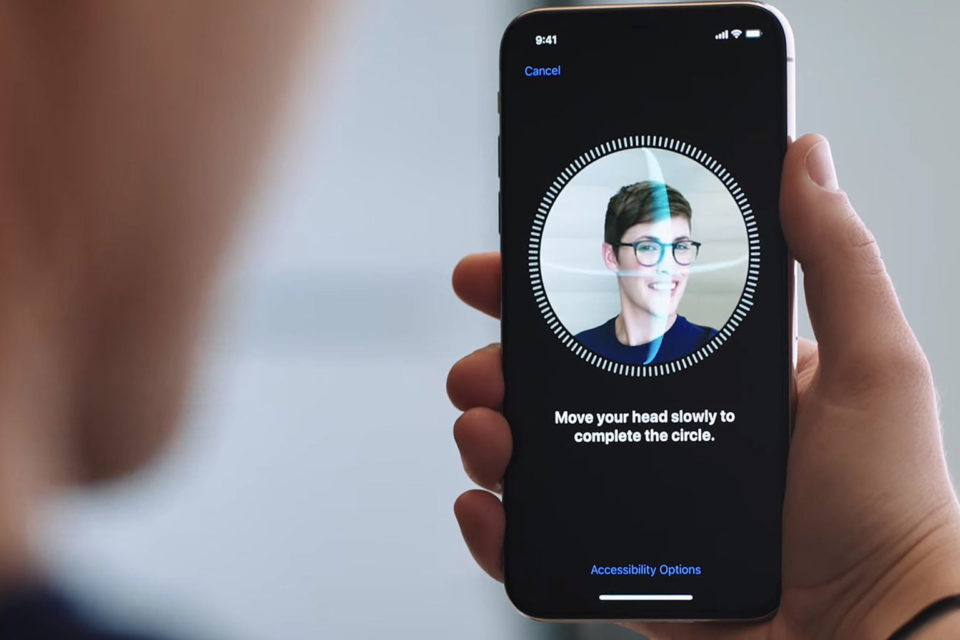
The reason the iPhone’s notch is so large is to house the necessary components for face ID which in Venice is the safest and most sophisticated facial unlocking system on a smartphone.
The notes face unlock is a convenient but insecure method that can be fooled by pictures of you. So for a more secure unlock method it also has an ultrasonic fingerprint scanner. This is embedded beneath the screen and therefore doesn’t obscure the display at all which is a huge advantage. It’s also faster than face ID well that you do need to place your fingerprint in the exact correct location each time which can be hard to do with the screen turned off, muscle memory does help you to get this right most of the time and of course you could wake the screen first but then it loses its speed advantage.
You also have the problem that dirt or moisture can sometimes stop you from using the scanner where its face ID works essentially every single time. Face ID for me is a much better biometric method overall but I can see the merits to both systems. The iPhone’s big notch is a heavy price to pay for face ID and as much as I love it I would take an under-display fingerprint scanner in order to get rid of the notch and give the iPhone a more modern look with just the front-facing camera on the screen. It’s really a choice of the convenience of face ID or the better aesthetic of the note fingerprint scanner.
Front Cameras
Both lenses have f 2.0 apertures but the iPhone has a slightly higher resolution lens at 12 megapixels versus 10 in the note 10 plus.
Normal mode

You can see the difference that higher resolution makes in how much sharper and more details the image taken on the iPhone is. The note seems to have smooth the skin texture even with Beauty mode turned off. The iPhone’s colors are also more natural and although Samsung’s image is still very good it is characteristically a little overexposed.
Portrait Mode

We essentially see the same result for portrait mode too with a sharper image it’s more accurate colors from the iPhone. I would say that note 10 plus has better edge detection though and if I zoom in on the arm and shoulder here you can see a much more refined indistinct edge compared to the iPhone. I also like that you have the option to save the previewed image directly to the camera roll on the note 10+ whereas on the iPhone this automatically flips the image.
Video
For the front-facing video, both cameras can record in 4k resolution. But iPhone is able to record 4k at 60 frames per second and in fact the only smartphone able to do so.
The stabilization is slightly better here too but especially the dynamic range. The picture is nice and bright on the note 10+.
On the iPhone only you can record slow-motion video on the front-facing camera.
One feature exclusive to the note 10 plus is live focus video. Allowing you to apply live focus lighting effects once recording. This works with both the front and rear cameras but is more effective on the front camera lens since the auto-tracking is more accurate for non-moving subjects.
Rear Cameras
Both phones have triple Lense camera systems with main telephoto and ultra-wide lenses. The notes 10+ also has a fourth time of flight camera used for depth information and 3d mapping.
Photo mode: Main Lens
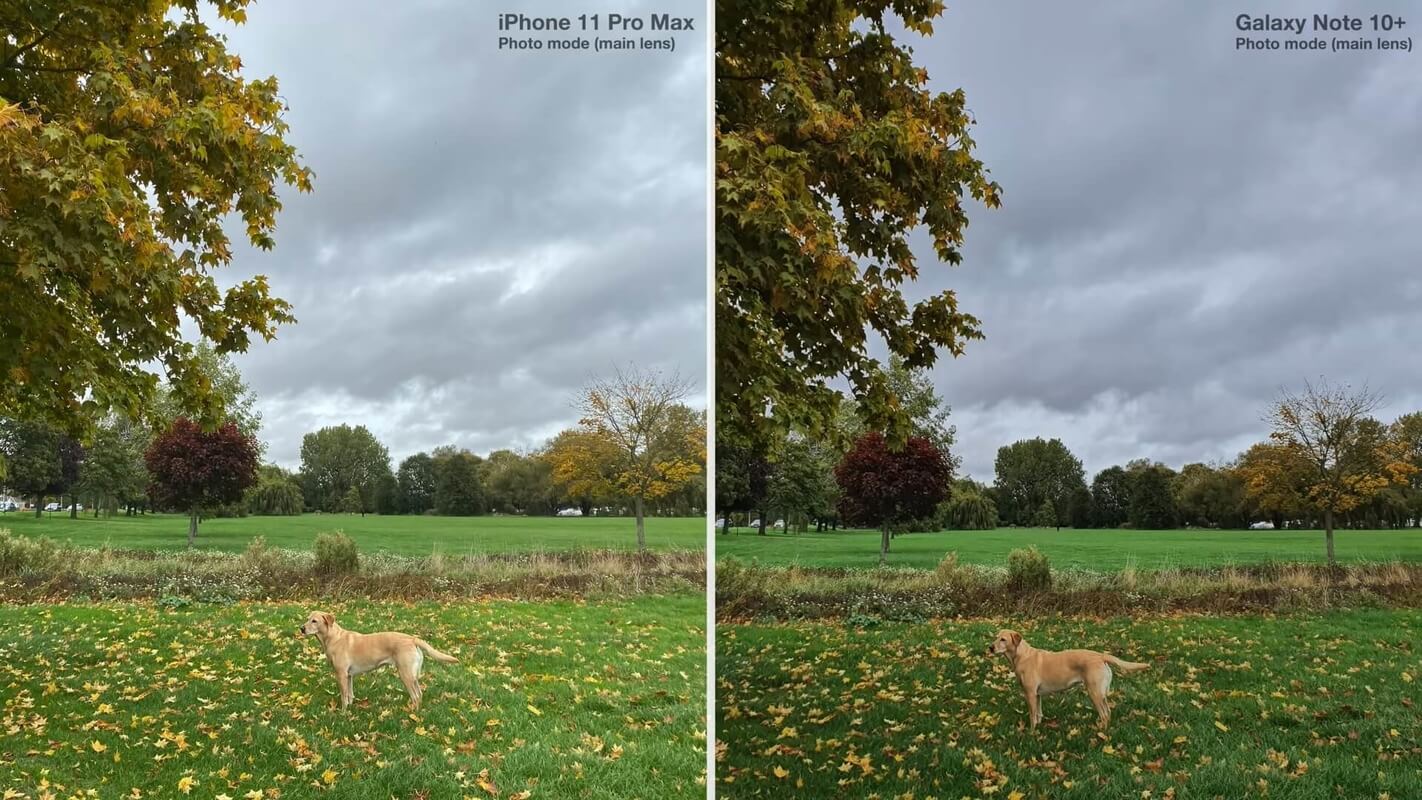
Both of these phones produce a really crisp and detailed photo and each camera excels in different situations. The iPhone produced more natural images whereas note 10+ tended to over process which has both benefits and drawbacks. In these images here the color is much more accurate and true to life on the left. There’s also a better dynamic range here so you can see a lot more detail in the clouds. The notes photo has this kind of blue hue to it if the colors are a little oversaturated.
Photo mode: Telephoto Lens

The contrast is a lot higher too so the picture really pops and stands out.
Photo mode: Ultra-Wide Lens

The 11pro max really stood out with how well it maintained consistency with its other lenses.
Night Mode
There is a dedicated night mode. The way low-light images can be quite different but there are definitely benefits to both. The iPhone does not support night mode in the ultra-wide lens. These both have great cameras but apple step ahead this year.
Night mode: Main Lens

In these photos, I like how much extra detail is revealed in the shadows on the right. A higher exposure in the shadows is actually a common theme with night mode on the note 10 plus which can rescue detail that would otherwise be lost. However, you can see that the colors are a little oversaturated especially in the dog’s fur in the grass which appears much more natural and lifelike on the left. The iPhones photo has a better dynamic range so the dog is really well exposed but the shadows are as dark as they appeared in real life.
Night mode: Telephoto Lens
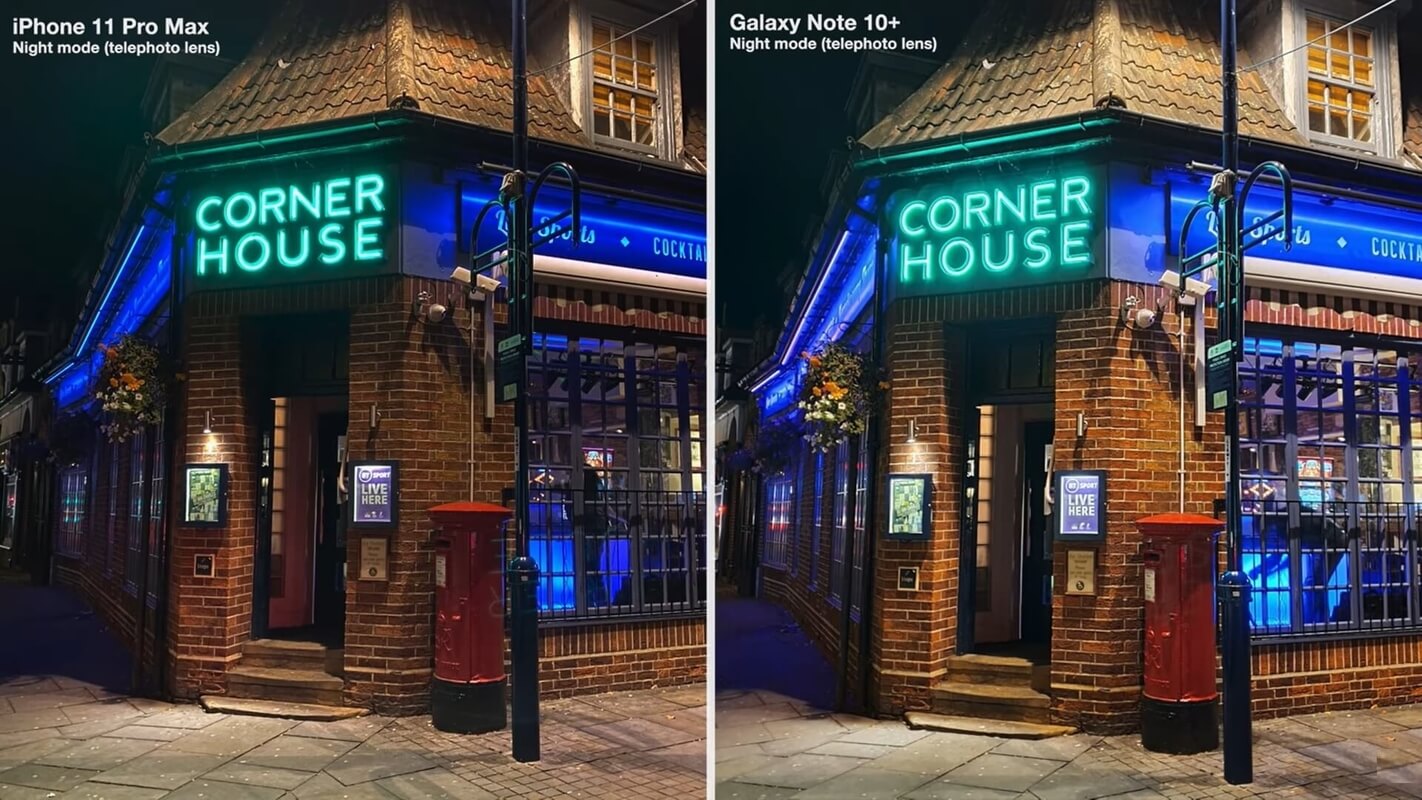
The same effect is happening with this neon sign here but in this instance, I actually think it works better for note 10+. Since the sign now appears more legible.
Battery/Charging
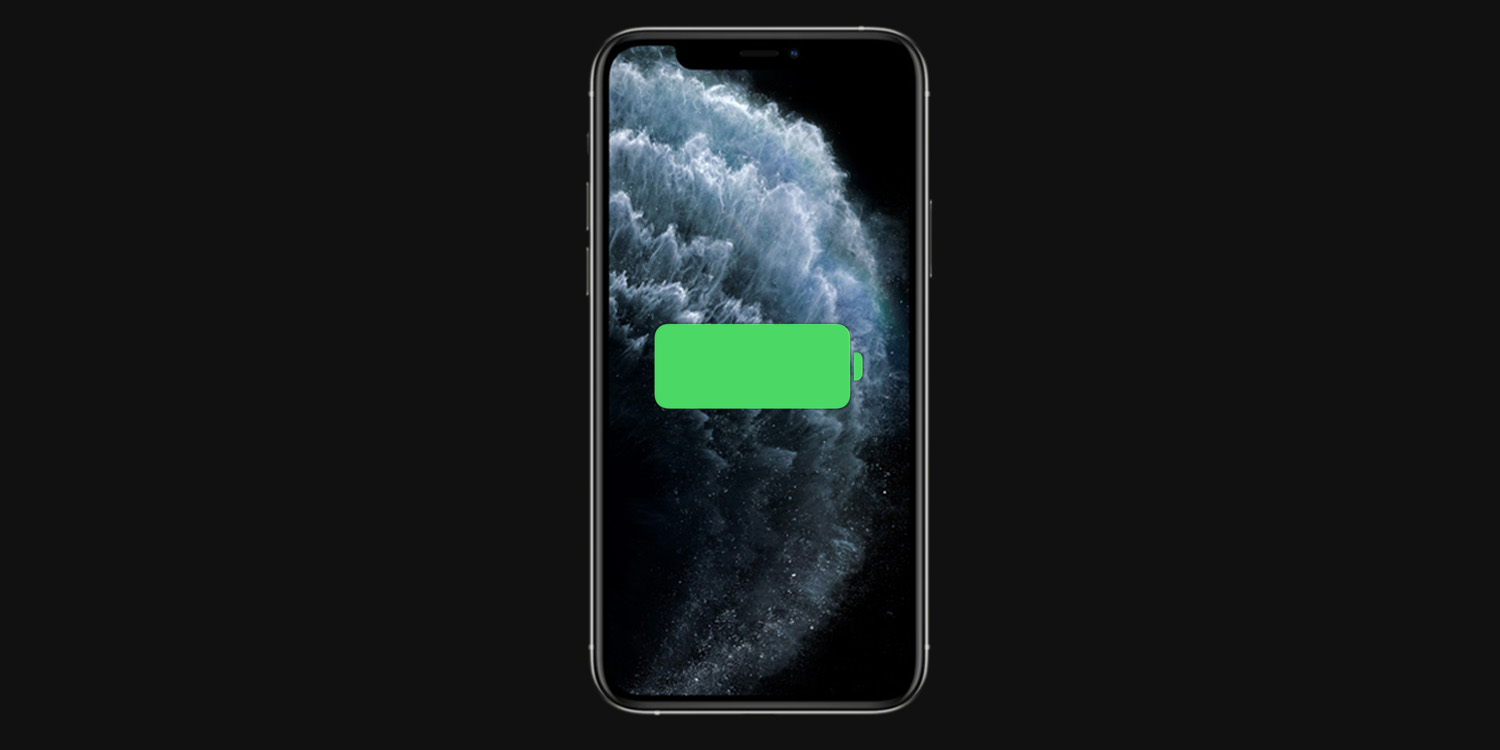
The huge battery life gains with the 11pro Max have allowed the iPhone not only to catch up but even overtake the note 10 plus. I was getting a decent 10 hours of screen on time with the note 10 plus but around one and a half hours show with the 11pro max.
The note does actually have a slightly larger battery inside but the iPhone’s battery optimizations and some new software improvements give it an edge when it comes to efficiency.
When it comes to charging though the note easily has the advantage. The note 10 plus can be fast-charged at forty-five foot speeds compared to just 18 watts with the iPhone.
You’ll need to buy this charger separately though since only a 25-watt charger comes bundled with the phone. For the first time ever the 11pro max finally comes bundled with a fast charger too. The iPhone can be fully charged in two hours but for a note in just one hour.
The note can also be wirelessly charged at faster speeds to with 15 watts charging support although you’ll currently only gets this with Samsung’s own wireless charger. So you’ll probably get just 10-watt speeds with most other chargers.
It also has support for reverse wireless charging allowing you to charge up devices by placing them on the back of the phone. You can actually charge up other devices here at faster speeds than the iPhone can be wirelessly charged. So Apple is clearly behind here.
Performance / Software
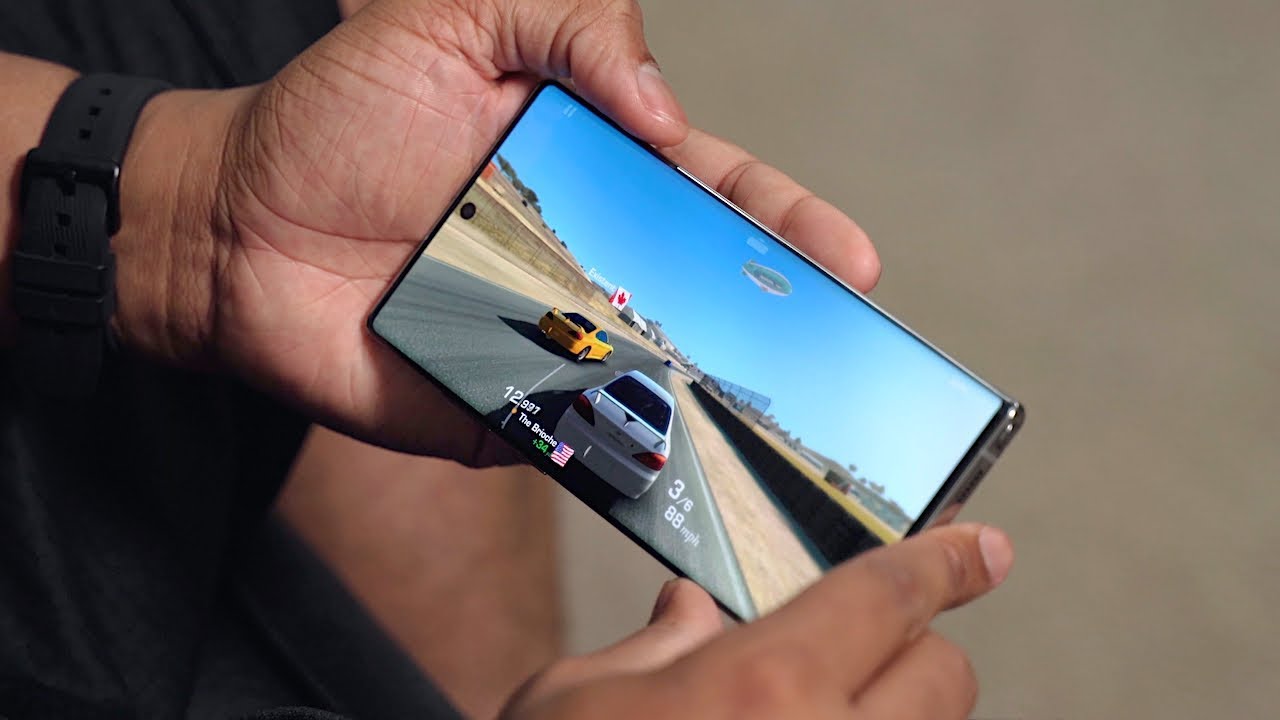
The 11pro max features apple’s new a 13 Bionic chip while the note 10+ has other the snapdragon 855 with the Exynos 9825.
In terms of raw performance the a13 is the more powerful chip of the two and in fact, is the most powerful chip you’ll find in a smartphone.
For those into mobile gaming though you can expect slightly better performance with the iPhone and a wider choice of better-optimized apps on iOS.
However, gaming is more immersive on the note 10+ because of its larger edge to edge display. So both phones make good options here.
When it comes to memory though Samsung how-to performs apple with 12 gigabytes of RAM versus just 4 gigabytes in the iPhone. Now, this difference isn’t quite as extreme as it first appears. Since iOS is better optimized for lower ram so much probably equate the iPhone four gigs to perhaps eight to ten in an Android device.
The note 10+ does offer much to performance when it comes to RAM and you’ll notice this when keeping multiple apps open in the background or when multitasking with many apps open at once. I really think Apple should have increased the RAM to at least 6 gigabytes on the 11pro Max because 4 just isn’t very Pro at all.
Multitasking is actually one of my favorite features of the note 10 plus. It gives it a huge advantage over the iPhone when it comes to productivity. Since on the iPhone you can only have one app open at the time.
Both of these phones have the power to function as your computer and with such a large screen size desktop start multitasking is made really easy by note 10 plus especially with the S Pen. You can take this experience one step further with Samsung dex literally allowing you to plug your note into a PC or Mac Book and use your phone as a desktop. This makes file management extremely easy and it just seems bizarre to me that I can connect my notes in my MacBook but not my iPhone.
Connectivity
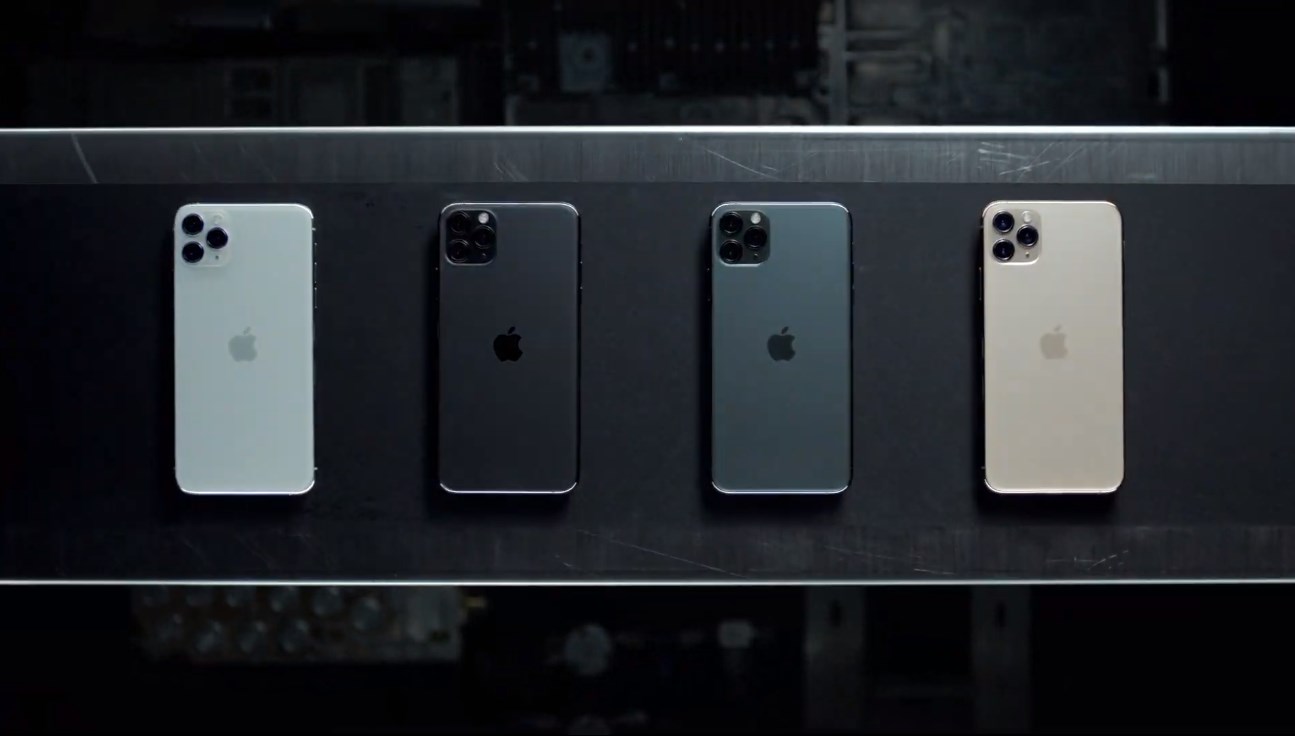
When it comes to connectivity both phones offer the latest Wi-Fi six but each offers their own unique data transfer technologies.
The 11pro max has apples u1 chip which uses ultra white man technology for spatial awareness. The technology is yet to be fully explored but so far you’ll be able to take advantage of precise file sharing through airdrop simply by pointing your phone at another device.
The note 10 plus on the other hand offers a 5g version of their phone. 5g technology isn’t quite ready yet so it’s essentially pointless to buy the 5g version now. It will take at least a couple of years for the network to be up and running with decent coverage but for those who would hang on to their phone for five or more years. It might be worth the early investment.
iOS vs Android
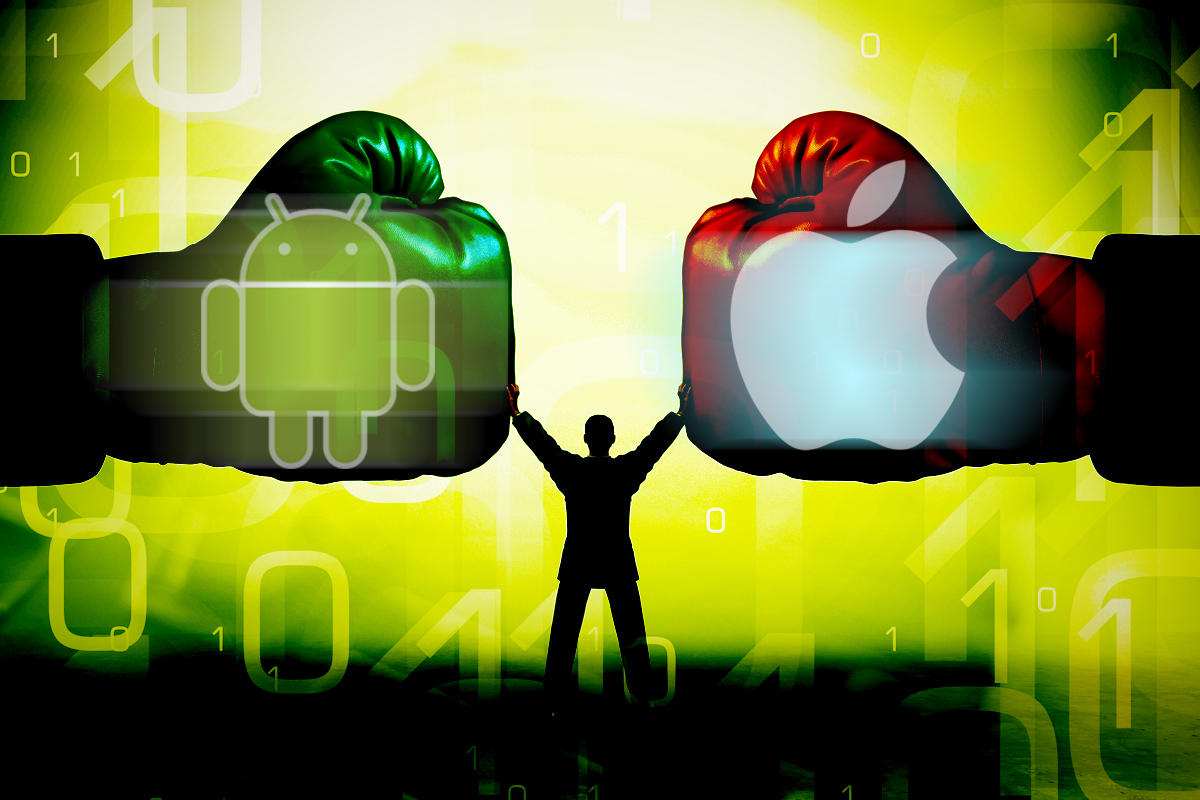
The performance and hardware differences are very similar with these two phones and just as in previous years the overall experience is largely dictated by the phone’s OS.
The same benefits and drawbacks of each are mostly unchanged with iOS generally offering a simpler and more fluid user experience. Gestures are smoother exclusive apps like iMessage FaceTime and notes are still excellent and the integration with other products in Apple’s ecosystem is best-in-class. The advantage of Apple designing its own processes and software is that there’s a level of integration and optimization that Android phones can’t compete with.
On the note 10+, the level of customization offered by Android completely outshines the iPhone. The vast array of custom themes settings and aesthetic options lets each week your device to give you a more personalized experience. Even something simple like hiding your apps in an app drawer is still not possible on iphone.
The note 10+ lets you take advantage of that huge screen real estate to do much more on your phone at one time and along with the s-pen the note 10+ is clearly the superior device for productivity.
The note 10+ would also be my go-to device for playing music. Since it supports low latency Bluetooth codecs like aptX and LDAC. In a world of wireless earphones and speakers this really gives the note an edge over the iPhone. It also supports instant pairing by NFC which is extremely handy especially when you have multiple NFC devices.
There’s no question that Android lets you do more. There are really strong arguments for both and to don’t think that either is necessarily better. It’s just going to come down to personal preference as to which you enjoy more.
Prices
We finally arrived at the very last thing to consider before buying these phones and that’s the price. The baseline models for each of these phones is a thousand and ninety nine dollars. And the prices then increase as you upgrade the storage. Don’t forget that the baseline 11 pro max has just 64 gigabytes of storage whereas this is 256 with the note 10+, to get this storage on the iPhone you’d need to spend an extra 150 dollars.
Conclusions
The iPhone 11 pro max is the best iPhone money can buy and a strong argument can be made for the Galaxy Note 10+ being the best phone on Android.
If you wanted to sum up the major differences between these phones then the iPhone offers superior cameras, battery life, and a simple interface on iOS.
The note 10 plus is much better for productivity as an abundance of features and offers complete customization on Android.
Which device you think is better will depend on which factors you prioritize and probably whether you prefer iOS or Android.
I personally couldn’t pick a winner but what’s clear to me is that the note 10 plus offers better value for your money.
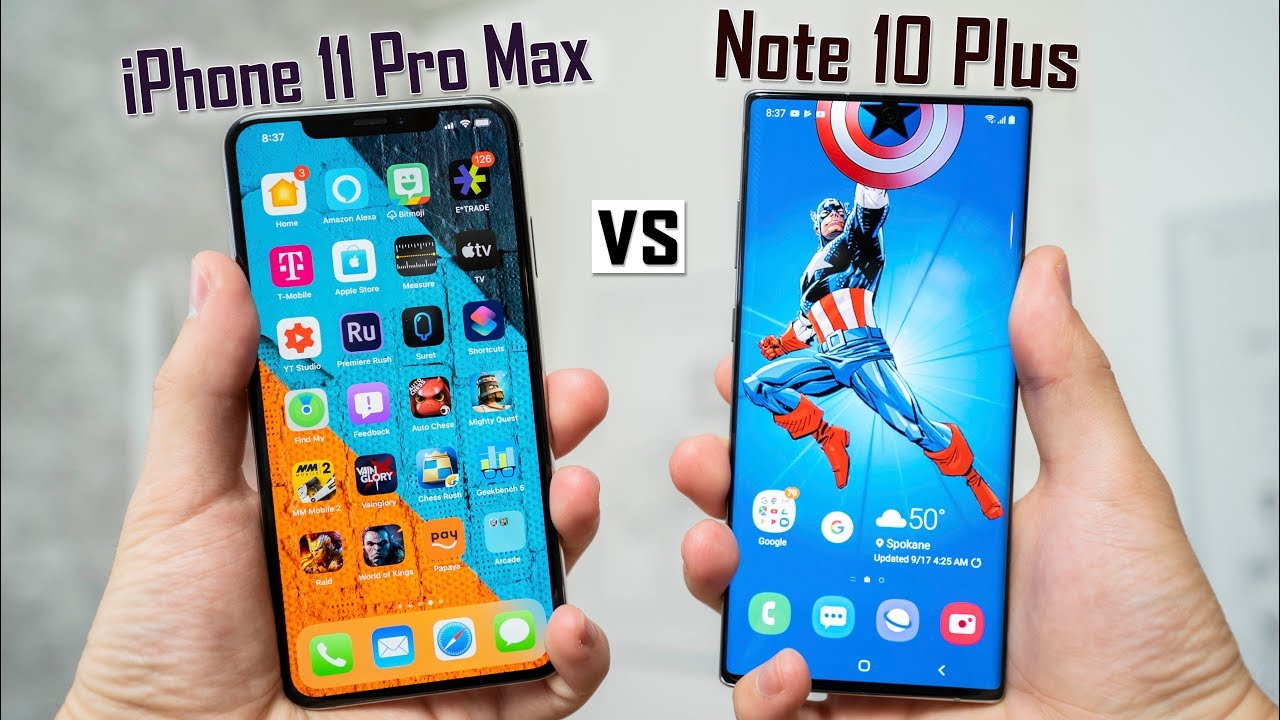
![iPhone 14 vs iPhone 13 vs iPhone 12 [Updated Guide]](https://www.theworldsbestandworst.com/wp-content/uploads/2022/11/iPhone-14-vs-iPhone-13-vs-iPhone-12-768x432.jpg)
